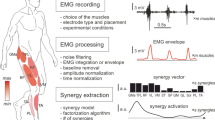Abstract
Apparatus is described for telementering electromyograph signals over a single frequency-modulated V.H.F. radio channel, also its use for measuring the periods of activity of leg muscles during normal walking on the flat. Results are given for eight male and six female subjects. Soleus contracts during the latter half of the support phase. Quadriceps contracts immediately prior to and during the first half of the support phase and again, in some subjects, as the opposite heel touches the ground. Hamstrings are active except during flexion of the knee during the swing phase. Flexors of the hip contract only at the end of hip flexion; some difference in timing between men and women was observed. The erector spinae on both sides contract twice per stride for a short period corresponding to heel contact of each limb. Inertial movements of the leg are stressed. Actions of the tibialis anterior, gluteus medius and maximus are also described.
Sommaire
Cette étude est menée en utilisant un appareil pour télémétrie de signaux électro-myographiques, fonctionnant sur un canal radio unique, en V.H.F., modulé en fréquence. Cet appareil est utilisé pour mesurer les périodes d'activité des muscles de la jambe au cours de la marche normale sur le plat. On présente les résultats des expériences menées sur huit sujets du sexe masculin et six du sexe féminin. Le muscle soléaire se contracte et se relaxe plus tôt qu'on ne pourrait s'y attendre. Le quadriceps se contracte deux fois mais pas pour l'extension de la jambe au niveau du genou. Les muscles postérieurs de la cuisse se contractent d'abord en antagonisme aux fléchisseurs de la hanche et ensuite en action motrice première de la cuisse. Les fléchisseurs de la hanche se contractent seulement en fin de flexion de la hanche, continuant une action antagoniste par rapport aux extenseurs. Une certaine différence des temps est observée entre les sujets masculins et féminins. Les muscles erector spinae se contractent deux fois de chaque côté pour contrôler le tronc du corps. Les mouvements d'inertie de la jambe sont soulignés. Le travail des muscles jambier antérieur, moyen fessier et grand fessier est également décrit.
Zusammenfassung
Ein Gerät zur Telemetrie von Elektromyogrammsignalen über einen frequenzmodulierten UKW-Radiokanal, sowie seine Anwendung zur Messung der Aktivitäts-perioden von Beinmuskeln während des normalen Gehens auf flacher Ebene wird beschrieben.
Die Ergebnisse von Messungen an acht männlichen und sechs weiblichen Versuchspersonen werden mitgeteilt. M. soleus kontrahiert und erschlafft früher als erwartet. M. quadriceps kontrahiert zweimal, aber nicht zur Extension des Beins im Kniegelenk. Die vom N. tibialis innervierten Muskeln des Oberschenkels (Mm. adductor magnus, semimembranaceus, semitendineus, caput longum M. bicipitis femoris) kontrahieren zunächst als Antagonisten der Hüftflexoren und dann als hauptsächliche Beuger des Oberschenkels. Die Hüftflexoren kontrahieren nur am Ende der Hüftflexion; sie wirken weiter als Antagonisten der Extensoren. Geringe Geschlechtsdifferenzen in der zeitlichen Koordination wurden beobachtet. M. erector spinae kontrahiert zweimal auf beiden Seiten zur Kontrolle der Rumpfstellung. Trägheitsbewegungen der Beine werden betont. Die Aktionen von Mm. tibialis anterior, glutaeus medius und maximus werden auch beschrieben.
Similar content being viewed by others
References
Allen, C. E. L. (1963) The University of Capetown lower limb prosthetic principle.S. Afr. med. J.,37, 607–616.
Close, J. R. (1964)Motor Function in the Lower Extremity. p. 79. Thomas, Springfield, Ill.
George, R. E. (1956) A transistor electromyograph amplifier,Ann. Phys. Med.,3, 66–67.
Report on Fundamental Studies of Human Locomotion Relating to the Design of Artificial Limbs (1947) University of California, San Francisco.
Sheffield, F. J., Gersten, J. W. andMastellone, A. F. (1956) Electromyographic study of the muscles of the foot in normal walking.Am. J. Phys. Med.,35, 223–236.
Author information
Authors and Affiliations
Rights and permissions
About this article
Cite this article
Battye, C.K., Joseph, J. An investigation by telementering of the activity of some muscles in walking. Med. & biol. Engng. 4, 125–135 (1966). https://doi.org/10.1007/BF02474155
Received:
Accepted:
Issue Date:
DOI: https://doi.org/10.1007/BF02474155




